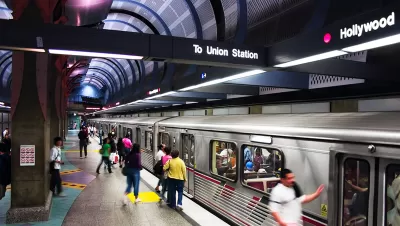Research links high ridership levels with lower crime, signaling that, rather than introducing new security measures, transit agencies should focus on bringing riders back to their systems.

In an opinion piece in the Los Angeles Times, Madeline Brozen urges Los Angeles Metro to look to the system’s buses as a model for how to improve transit safety.
While the agency is deploying added security, transit ambassadors, and other tools such as loud music to deter crime in its stations, Brozen writes that those may not be enough to make trains safer. Yet riders on the system’s buses experience far less crime than train users. “Buses aren’t safer because their rubber tires act like crime-fighting vigilantes. The most likely explanation for why buses are safer is because more people use them.”
“As fewer people rode public transit — particularly the train system — social norms eroded. Behaviors changed from minor issues like passengers putting their feet on seats to more concerning behaviors like smoking cigarettes or openly using drugs.” According to Brozen, “The best way forward is to take lessons from the bus and get more people on board to enforce public transit’s social norms.”
To bring back ridership, Brozen suggests “focusing on rail riders who are not weekday commuters,” a strategy recently undertaken by San Francisco’s Bay Area Rapid Transit Authority (BART). Brozen also recommends activating rail stations, which are often empty and isolated.
Ultimately, “Whatever steps L.A. Metro takes to address crime should be good solutions for transit in general, not just for safety,” and transit can’t solve larger societal problems. But “The bus system’s relationship between more riders and less crime is proof positive” that boosting ridership can be one tool for addressing transit safety.
FULL STORY: Opinion: How can L.A. Metro make train service safer? Look to what’s working on buses

Alabama: Trump Terminates Settlements for Black Communities Harmed By Raw Sewage
Trump deemed the landmark civil rights agreement “illegal DEI and environmental justice policy.”

Planetizen Federal Action Tracker
A weekly monitor of how Trump’s orders and actions are impacting planners and planning in America.

The 120 Year Old Tiny Home Villages That Sheltered San Francisco’s Earthquake Refugees
More than a century ago, San Francisco mobilized to house thousands of residents displaced by the 1906 earthquake. Could their strategy offer a model for the present?

Opinion: California’s SB 79 Would Improve Housing Affordability and Transit Access
A proposed bill would legalize transit-oriented development statewide.

Record Temperatures Prompt Push for Environmental Justice Bills
Nevada legislators are proposing laws that would mandate heat mitigation measures to protect residents from the impacts of extreme heat.

Downtown Pittsburgh Set to Gain 1,300 New Housing Units
Pittsburgh’s office buildings, many of which date back to the early 20th century, are prime candidates for conversion to housing.
Urban Design for Planners 1: Software Tools
This six-course series explores essential urban design concepts using open source software and equips planners with the tools they need to participate fully in the urban design process.
Planning for Universal Design
Learn the tools for implementing Universal Design in planning regulations.
Clanton & Associates, Inc.
Jessamine County Fiscal Court
Institute for Housing and Urban Development Studies (IHS)
City of Grandview
Harvard GSD Executive Education
Toledo-Lucas County Plan Commissions
Salt Lake City
NYU Wagner Graduate School of Public Service





























